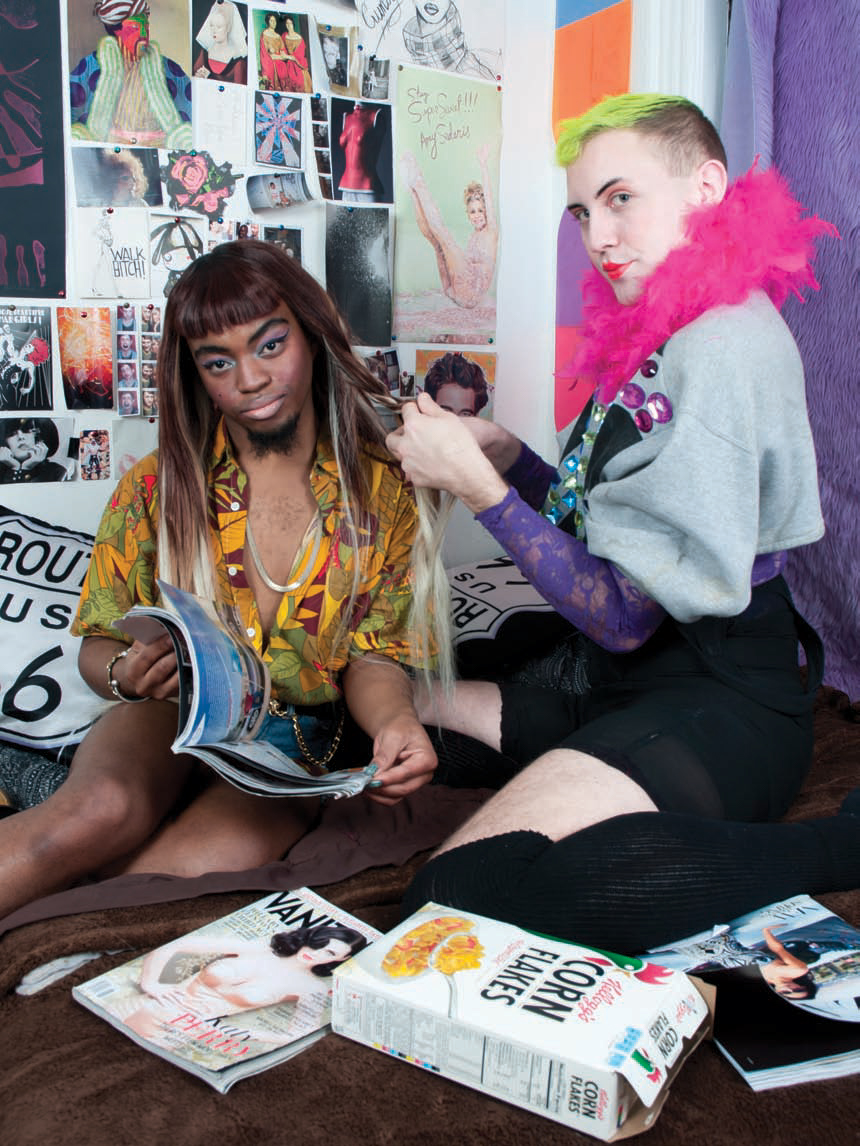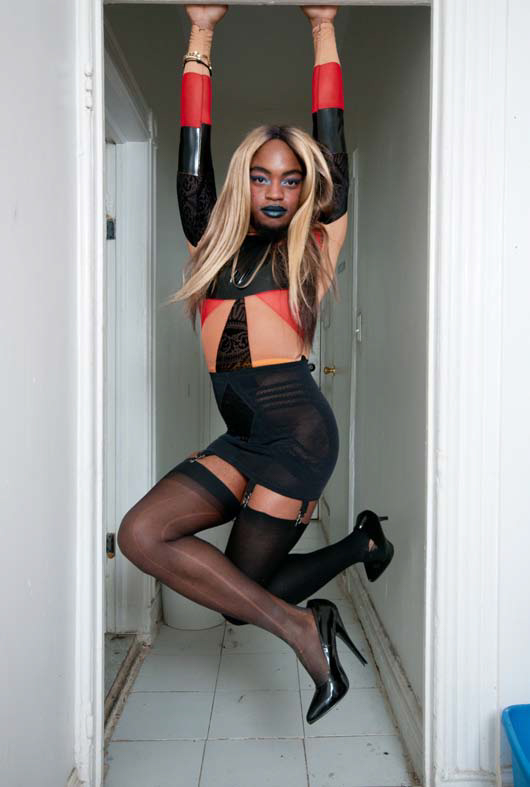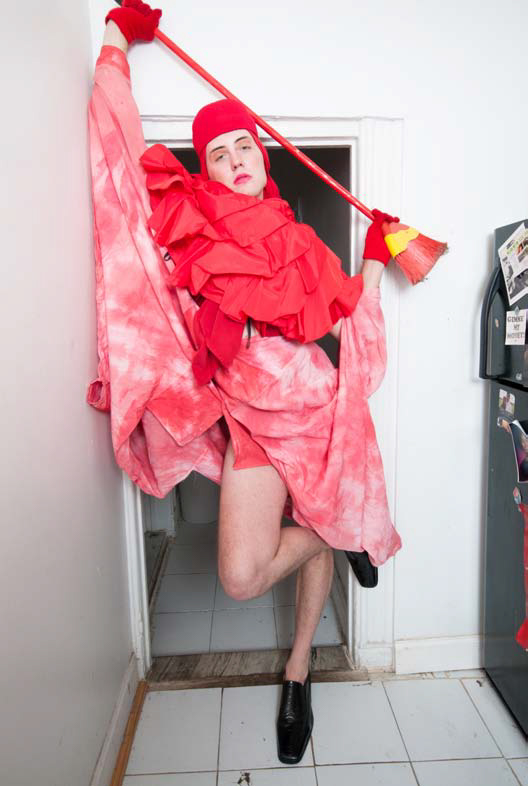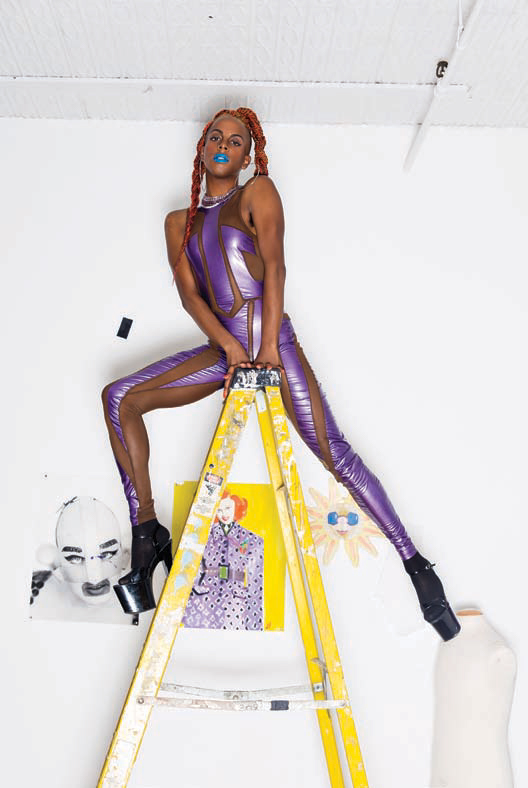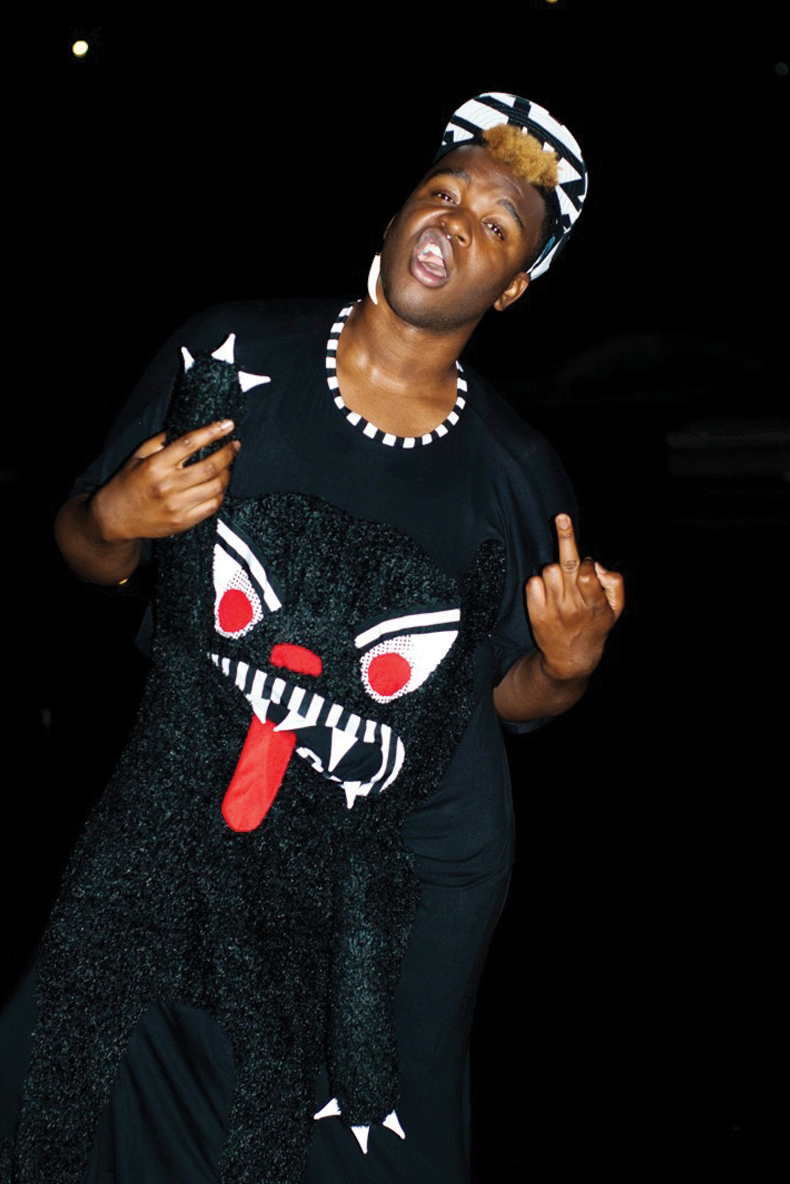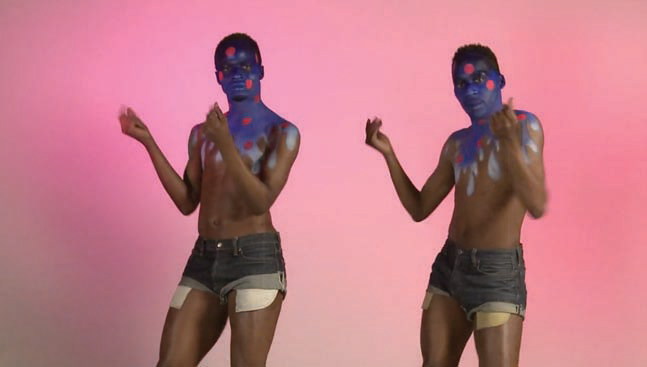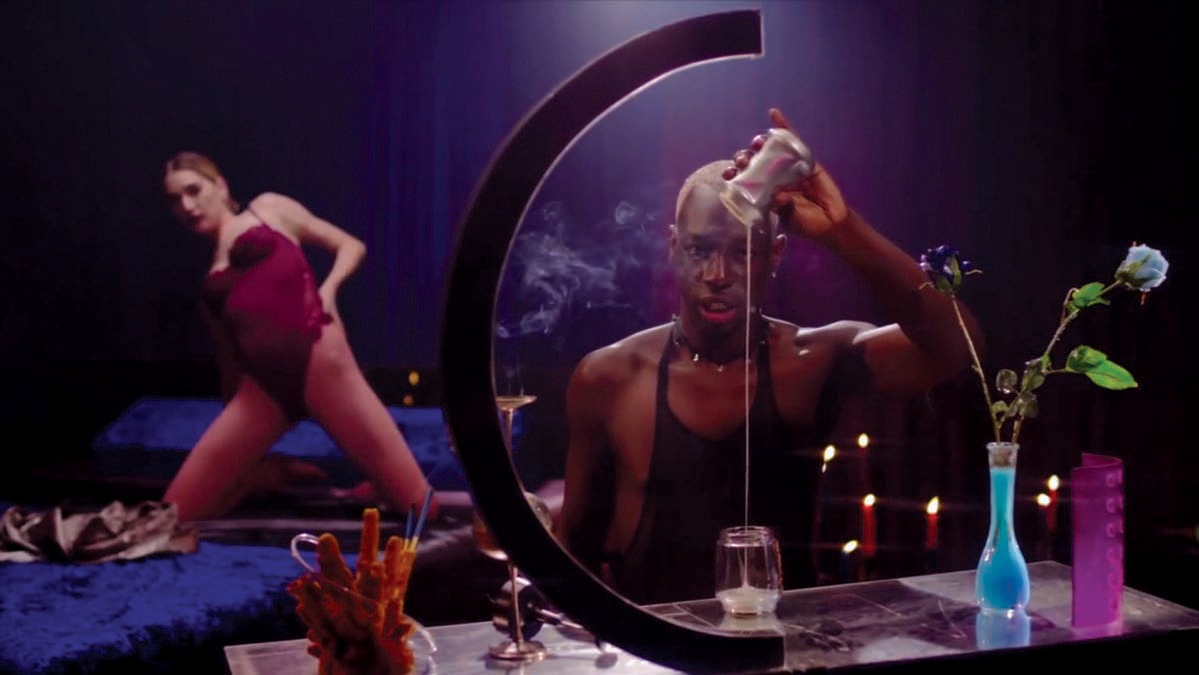Neither Queer nor There
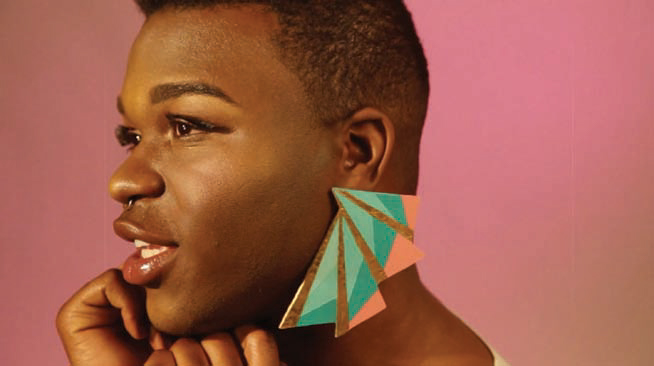
Cakes Da Killa, video stills from Goodie Goodies [courtesy of the artist]
Share:
Big false eyelashes being batted and white rose blossoms planted high in a naked man’s buttocks. Vivid gender fluidity and non-normative sexual practices. Bearded ladies, anime, and Billie Holiday. Confident passes through club scenes and across dance floors. Twerking, stripping, voguing. Haute couture and the superheroic erotic futurism of BCALLA fashions. Le1f’s otherworldly pronouncement: “This mattress is Atlantis.” Bougie, rachet, skag drag. House of LaDosha’s frankly forceful “It’s not just bitches, it’s witches/The seventh layer of Bushwick/They ride a wicked dick, they keep it light as a feather and stiff as a board.” Further neopaganism as Mykki Blanco identifies her project as “black magic music nigga, blanco hoodoo.” Harlem Renaissance, “Cuntology,” and H.A.M. (Hard As a Motherfucker). Paris Is Burning, and in the opening of Big Momma’s Mommie Dearest, pussies are burning. The mythic offspring of Naomi Campbell known as Dosha Devastation, whose voracious pansexuality and morphing, hermaphroditic body avails her to all forms of sexual delight. Cakes Da Killa’s call-outs and critiques of the entire framework of “gay” or “queer” rap, including his snarky send-up to the fanfare surrounding out R&B singer Frank Ocean’s “Thinkin Bout You,” when on his track “Da Good Book” he rewords the tune as, “I’ve been thinking bout dick/Do you think about it too?” Setting themselves in contrast to a turn toward LGBTQ issues in music already under way by the likes of Ocean (not to mention the straight-identified Macklemore and Ryan Lewis’ chart-topping gay rights hip-hop anthem), these artists were the ones who compelled my photographer friend Michael Reece to say that this cultural moment is what he’d been waiting for his whole life. Friends and colleagues across the country concurred.
LaFemme LaDosha and Cunty Crawford LaDosha [photo: Amos Mac]
Le1f, Mykki Blanco, House of LaDosha, Cakes Da Killa, and Big Momma are among a burgeoning new wave of artists who have been contentiously identified with a turn toward “queer rap” over the past several years. The phantasmagoria called into being by this group is built from a wild web of references that imagines new directions for rap and hip-hop while leaving behind the rigid portrayals of gender and subtextual (when not blatantly explicit) homophobia that have been the genre’s staples. The campy, poppy stylings of such rappers as Cazwell and Big Dipper, as well as Sissy Bounce royalty Big Freedia, also figure in a surge of recent press that has controversially used queer theory’s intellectual (or, more candidly, academic) trappings to interpret the content and practices of these musicians. I am certainly implicated in this curious problem between production and interpretation. As I’ve been exposed to these artistic projects, they have seemed to me to generate returns on queer theory’s work to dismantle oppressive categories and to pose inquiries that don’t just allow for but even anticipate difference, pluralism, and nuance in intersectional identity formations. And it was as a queer-identified artist and writer that I first experienced the lyrics full of risqué same-sex desire and endlessly fanciful permutations of gender expressions running through layered musical sensibilities that draw from Lil’ Kim’s hard femme bitchery and richly textured cloud rap. But while my approach to this music is a queer one, my research into these various artists and discussions with them reveal certain tensions with queer identification. If these musical projects are adamant about portraying their own sexualities and sexual fantasies, there is also the refusal to be delimited only to the homosexualities that “queer” is commonly used to connote. I aim to consider these artists’ ascent into visibility, the discursive limits of language as it has framed their exposure, and how those frameworks diverge from the politics of their self-constructive methodologies.
LaFemme LaDosha [photo: Amos Mac]
Cunty Crawford LaDosha [photo: Amos Mac]
In conversation with Gerry Visco for Inter-view magazine’s website, Cakes Da Killa said, “I’m not queer. I hate that word. It’s not in the black community. I like ‘cunt.’”1 In another interview, when I asked what “queer” meant to him, he answered, “It doesn’t mean anything to me. I understand what the term means since I always surround myself with LGBT literature and cinema, but the term isn’t really a part of my experience being a gay male of color.” Magatha “Father” LaDosha, in a zine that accompanies the House’s 2013 exhibition The Whole House Eats, acknowledges in passing the different reactions to being grouped: “There was a huge movement called out by endless press outlets about the ‘queer hip-hop’ scene coming out of this city right now. Whether the artists grouped together in this trend piece were happy about it or not, it’s undeniable that the exposure can only have a positive influence [for] queer youth around the world.”2 Cunty Crawford LaDosha (Adam Radakovich) observes how limiting it can be to have these musical projects categorized by sexuality: “People are simplifying gay people to say it’s ‘gay music.’ Gay people are listening to a lot of different types of music, and gay people are making a lot of different types of music. There might be a lot of gay rappers, but it’s not all the same.”3 Big Momma, on the other hand, explained to me how “queer” functions ambivalently both as a reclaimed term of empowerment and as a slur still commonly employed. Still, he adopts the term. “I am a queer. I’m strange, odd, unusual, and bizarre.” As much as these artists might be grouped by the articulations of homosexual and non-normative desire in their music, they also comprise a spectrum of disidentification with a queer politics, at times shirking it categorically in much the same way it was itself intended to break down restrictive social constructions that preceded its arrival in parlance. The artists’ objections scrutinize queer theory’s ability to work in the service of extremely diverse social positions instead of being co-opted, as it is often critiqued as an even further-reaching signification of education-classed white male privilege.4
Is it possible to recuperate “queer” as a concept that is inclusive of the many divergent identifications at work in these projects? What other means are available to theorize the heterogeneity and hyper-attuned specificity of the spaces these artists occupy? Just as problematic would be to presume that an individual’s expressed subjectivities, personal truths, and personalized niches are treated more equitably outside queer theory than within the liberation politics queer theory aims to stage. Despite the appearance of subjectivity to individuate and to subvert dominant paradigms, the systems of thought that produced commonplace notions of “the subject” (Hegel, psychoanalysis, etc.) are fraught with underlying hierarchies that organize subjects’ accounts of themselves in relation to more or considerably less privilege, access, and exposure through subtle (when not blatantly explicit) forms of sexism, racism, and prejudice. If, in these discourses, “queer” is disavowed, how does one write around the practices under consideration without reverting to the lure of subjectivity? What is this sung-about Neverland if it is not “queer space”—not, that is, the much affeared “Queer Planet” Michael Warner foretold—and what then can we call it?
Juliana Huxtable [photo: Michael Burk]
Cakes Da Killa [photo: Matt Lambert]
In a reappropriative gesture not unlike that which “queer” underwent, Cakes and LaDosha’s use of “cunt” as a signifier of pride and praise also troubles conventional demarcations of gender expression as sexuality. This circulation of terminology flowing, seemingly, in a free play of signifiers and signification also points to rap’s propensity for new meanings coined—notably the rebranding of “nigger.” This updated “cunt” recalls, however knowingly, subversive philosopher Georges Bataille’s preference for “cunt” in his own esoteric sexual imagination, and so this usage is but another example of what Patricia Hill Collins observes is “a reworking of historical language … situated at an ideological crossroads that both replicates and resists intersecting oppressions.”5 It is Collins’ aim to temper the radicality of new uses of language with a risk assessment that accounts for the good and harm simultaneously at work in the crafting of vocabularies with which to propose alternative worlds and social structures.
One hopes for new, reconciliatory terms of engagement that extend the queer theoretical project’s work to interrogate and deconstruct the apparatuses constituting social categories and their resultant oppressions, but that nonetheless keep intact the specific needs, desires, and traits characterizing an individual’s experience. E. Patrick Johnson attempts to theorize such a tenuous position by expounding on “quare” as an alternative that allows for a “culture-specific positionality … I find absent from the dominant and more conventional usage of ‘queer.’”6 As a term, “quare” is already marked with cultural specificity, drawn as it is from the Anglo-Irish (as in Brendan Behan’s The Quare Fellow) as well as Johnson’s Southern grandmother’s pronunciation of “queer.” Such cultural marking strikes in the space between broad categorical terms and discrete subjective identities, where Johnson finds material experience as a useful counterbalance to academia’s detached discourses. While not being fully exempt from categorical language such as “gay,” “Black,” or “educated,” the difference in approach is in noting the accumulations of traits, qualities, and circumstances that are at play in a cultural position. While the model of an ontologically stable subject that has been advanced from psychoanalysis into essentialist identity politics might be imagined as a hard, solid, and rigidly inflexible form, an alternative might be to track the flickering, ever-shifting coordinates where aspects of material living intersect. When asked by Nate Freeman about the prolific flow of eccentric images, scenarios, and mythologies authored by House of LaDosha, Cunty Crawford LaDosha reflected, “I guess it’s just looking at things we find interesting or funny and then incorporating [them] into the way we talk to each other—our very gay New York language. And we’re all very creative so it’s very natural to have this.”7 Affect, humor, sexuality, location, and dialect are all fluid contributors in the production of just this passing comment on House of LaDosha’s creative output. For these artists, adopting the familial house structure from New York’s drag ball scene means operating from a hybridized collective position. It may be that “house” does everything that “queer” could hypothesize, working as a flexible category from which different racial, gendered, or otherwise classed perspectives may be momentarily empowered, experimented with, or deconstructed.
Cakes Da Killa, video stills from Goodie Goodies [courtesy of the artist]
It may be that, despite itself, “queer” is too constant and consistent a term to be able to signal the jump between the multiple roles and identifications these artists occupy. They are musicians who are also artists who exhibit in galleries—or are graphic designers, fashion designers, dancers, choreographers. In an era of hyphenated, flexible labor, these multidisciplinary practices may not be immediately of note. But such movement across many platforms further emphasizes the rapidity and ephemerality of occupying any cultural position for very long. Some such accruals are incidental and temporary, but still very compelling. Take for instance the free distribution of nearly all of the music under discussion in this essay. While conversations with a number of the musicians revealed that this move was necessitated through the sampled beats and other appropriations that would make them susceptible to copyright infringement, there is strange appeal in the juxtaposition of material affluence scripted within their lyrics and Cakes Da Killa’s exasperated observation in our conversation that “No one’s buying music at the moment because everyone is poor!” This circumstantial nonparticipation in capitalism through their music sets in pronounced relief the eagerness with which such artists as Macklemore will occupy and profit from problematic categories including “gay” and “queer.” It may be that “queer” is too easily absorbed as a unit of cultural currency by hegemonic systems of control with which straight, White, male-identified mainstream musicians are able to align themselves.
In contrast, the cultural positions espoused by these artists’ practices draw from the marginal rather than the centrally hegemonic. When developing language with which to describe life along those outer edges, it becomes interesting to account not only for the “real” material experiences of the performers, but also for the fantasies, hyperbole, and metaphor that extend cultural positions into what Cunty Crawford LaDosha calls “projected self realities.”8 Alongside explicit treatments of sex in the songs, the power of self-construction by means of witchcraft, superpowers, and altered states preoccupies all of these artists. Be it in LaDosha’s aforementioned Brooklyn witchcraft, Cakes da Killa attesting “that’s the power of my goodies goodies,” the incantations in Mykki Blanco’s video for “Invocation,” or various other blends of mystical and spiritual tropes, a recurrent aspect of their cultural positions is that they reserve the control to remake, transform, and shift themselves. Although opaque and poetic, many of Le1f’s lyrics envision ways of being that graft the physical, sensuous, and bodily into the multifarious and diffuse:
Take the ghost out the shell like we’re megatech/
Get addicted to my realness like it’s Internet/
Get raw/Get live/Dissolve/Transform/ Get right/ Evolve/ ….
I do a sailor moon transformation so handsomely/
So quick and rapidly, I assemble up the cavalry/
You know we’re armed & dangerous & talented & camp & street/
I’m touching up on your chakra, are you nervous yet?/
I start on the violet side and heal you all the way to red/
There’s your body. Where’s your mind, where’s your head?9
Le1f, video still from Hush Bb, director: Alex da Corte [courtesy of the director]
Embodiment here is an assemblage of place, skill sets, and camp situated against ethereal metaphors such as ghosts, networks, and magical anime moon princesses. Le1f’s recent collaboration with bricolage artist Alex da Corte on the video Hush Bb reinforces these impulses toward both the heterotopic and the self-empowered mystic through the cluttered boudoir setting (reading much like one of da Corte’s homoeroticized sculptural conglomerations) and sequences of bodies shifting gender, race, and orientation to the gaze of the camera. A treatment of cultural position as temporary and frequently shifting assemblage resonates even with the mixtapes and tracks these artists release on the Internet, constructed as they are from densely layered appropriations and fragmented references.
What we have been waiting our whole lives for is not a response to the ideals that have propelled the queer theoretical project per se. Queer theory is just another site of recognition wherein femme, drag, genderfuck, bracingly vivacious, and empowered personalities spin stories of anger, seduction, enchantment, and reverie with which we can identify. These creative spaces running alongside “queer” may be dubbed cunt, quare, or culturally positioned; and it’s in fact probably preferable to leave all the alternatives in play. The plurality of how we might characterize these musical projects directs attention to the unsettling (for better or worse), sometimes-too-slippery and other times oppressively rigid ways that language mediates material experience. Although it may seem fussy to parse the terms, either accepted or contended, by which art forms are named, such analyses can reveal the heightened stakes around cultural exchange: who is obfuscated, who is profiting, and who may be prevented from moving into the projected self-realities they have laid out ahead of themselves.
NOTES
Unless otherwise noted, all quotes are taken from interviews I have conducted with these artists. I have used correct pronouns where provided, and have followed pronoun usage in other media coverage where they have not been specified. My deep gratitude to Christopher Backs, Matt Joynt, Michael J. Morris, and Eric Ruschman for their assistance.
References
| ↑1 | Gerry Visco, “Exclusive Video Premiere and Interview: ‘Goodie Goodies,’ Cakes Da Killa,” Interview, www.interviewmagazine.com/music/ exclusive-video-premiere-and-interview-goodie- goodies-cakes-da-killa |
|---|---|
| ↑2 | “The Whole House Eats,” Bdgrmmr, issuu.com/ badgrammar/docs/the_whole_house_eats |
| ↑3 | Juliana Huxtable LaDosha, “Am I Carrying? An interview with House of LaDosha,” Cluster Mag, Issue 4-Parties, www.theclustermag.com/2012/03/ am-i-carrying-an-interview-with-house-of-ladosha |
| ↑4 | For example, in Gloria Anzaldúa’s “To(o) Queer the Writer: Loca, Escrita y Chicana,” in Inversions: Writing by Dykes, Queers, and Lesbians, ed. Betsy Warland (Vancouver: Press Gang, 1991), 249–263. |
| ↑5 | Patricia Hill Collins, Black Sexual Politics: African Americans, Gender, and the New Racism ( New York: Routledge, 2005), 121. |
| ↑6 | E. Patrick Johnson, “‘Quare’ Studies, or (Almost) Everything I Know about Queer Studies I Learned from My Grandmother,” in Black Queer Studies: A Critical Anthology, eds. E. Patrick Johnson and Mae G. Henderson (Durham, NC: Duke University Press, 2005), 126. |
| ↑7 | Nate Freeman, “House of Ladosha is C-Word Bound,” Interview, www.interviewmagazine.com/culture/ house-of-ladosha-the-whole-house-eats |
| ↑8 | “The Whole House Eats.” |
| ↑9 | Le1f, “Mind Body.” Dark York, 2012, MP3 mixtape. |
